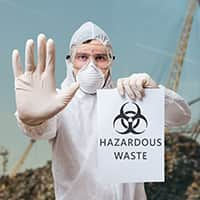Comprehensive Education for Safe Handling of Hazardous Waste
Written by Staff Writer

Working with or around hazardous materials requires a deep understanding of proper safety measures and regulatory requirements. From site cleanup operations to managing waste in treatment facilities, organizations must prioritize compliance with Occupational Safety and Health Administration (OSHA) standards.
This focus on compliance includes specialized learning programs under the Hazardous Waste Operations and Emergency Response (HAZWOPER) standard and the Resource Conservation and Recovery Act (RCRA). By selecting the appropriate courses, workers reduce risks, maintain legal compliance and help cultivate a safer work environment.
Below is an overview of essential training programs, how they contribute to workplace safety, and why refresher courses are a mandatory component of regulatory compliance. The information will guide decision-makers in choosing the correct program — whether it is an initial HAZWOPER course or specialized RCRA instruction — so that every involved party remains protected from potential hazards.
Understanding HAZWOPER and Its Role
HAZWOPER is a set of standards created by OSHA under 29 CFR 1910.120 and 29 CFR 1926.65, requiring specific training for employees who encounter uncontrolled hazardous substances or may be involved in emergency response activities. The primary goal of these standards is to reduce the likelihood of injuries, illnesses and environmental damage stemming from improper handling or exposure to dangerous materials.
HAZWOPER regulations identify five types of operations that require specialized instruction. These operations include cleanup at designated waste sites, responses to emergency releases of hazardous substances and work in facilities regulated under the Resource Conservation and Recovery Act.
By completing the correct HAZWOPER course, employees strengthen their knowledge of toxicology, personal protective equipment (PPE) and safe work practices that directly relate to hazardous waste operations.
The Importance of RCRA Training for Hazardous Waste Management
While HAZWOPER centers on controlling exposure to dangerous substances and responding to emergencies, RCRA focuses on the "cradle-to-grave" management of hazardous waste. Facilities producing or handling regulated wastes must meet stringent Environmental Protection Agency (EPA) requirements. This approach aims to safeguard public health and protect the environment from the mismanagement of hazardous materials.
Training programs under RCRA emphasize proper waste categorization, manifest completion and disposal practices. The emphasis on comprehensive recordkeeping helps verify that hazardous waste is tracked correctly from generation to final disposition, reducing the chance of illegal dumping or accidental contamination.
Meeting Annual Update Requirements
Certain businesses known as Large Quantity Generators (LQGs) produce or manage significant volumes of regulated substances. Staff at these facilities must consistently show they can uphold RCRA guidelines. The 8-hour RCRA refresher is designed for employees who already have baseline knowledge but need an annual review of essential topics such as:
- Identifying and classifying solid, dangerous and non-hazardous materials
- Completing manifests and maintaining required documentation
- Effective recordkeeping for accurate reporting
- Corrective actions and cleanup processes outlined by the Act
- Best practices for safe management from cradle to grave
Selecting the Right HAZWOPER Course
Choosing among 40-hour, 24-hour and 8-hour HAZWOPER courses depends on job responsibilities and the level of potential exposure to hazardous substances. For individuals handling high-risk duties — such as operating equipment at uncontrolled hazardous waste sites or dealing with unknown substances — the 40-hour course is generally mandatory. Those working in less hazardous scenarios or only visiting sites periodically may qualify for the 24-hour version.
After completing either the 24-hour or 40-hour program, employees must follow OSHA's annual refresher requirement by taking an 8-hour HAZWOPER class. This yearly refresher is intended to reinforce critical concepts and address any changes in regulations or worksite practices.
Missing this window can compromise certification and lead to costly retraining. By staying proactive, businesses maintain compliance and create a safer environment for all personnel.
Benefits of Online Training
Online learning offers a flexible alternative to traditional classroom sessions. Participants can complete their modules at their own pace, allowing them to balance professional commitments with crucial educational requirements. Additional advantages include:
- 24/7 Course Access: Learners can log in any time, making scheduling easier for shift-based roles
- Interactive Lessons: Quizzes, case studies and real-world scenarios help reinforce concepts
- Easy Testing and Certification: Unlimited quiz attempts and downloadable certificates upon course completion
- Cost-Efficiency: No travel expenses or time away from job sites, which benefits both employers and employees
- Expert Support: Many programs offer email or chat assistance, guaranteeing that participants receive timely responses to questions
Enroll in HAZWOPER and RCRA Courses for Ongoing Safety
Organizations and individuals can explore different course options to match their specific regulatory requirements and workforce needs. Enrolling in an 8-hour HAZWOPER refresher, 8-hour RCRA refresher or a shorter 1-hour RCRA general awareness program ensures staff remain up to date on essential protocols.
Steady, thorough instruction helps risky locations function smoothly while urgent responses run more effectively. Also, rule enforcers often request proof via documents during inspections. Holding up-to-date records lowers odds around penalties or halted operations.
Solid direction on dangerous materials preserves lives, curbs ecological harm, plus upholds a company's standing. Whether someone is new or renewing long-standing eligibility, ongoing knowledge regarding these standards remains key. Awareness benefits all — frontline crew, management, plus surrounding communities.
